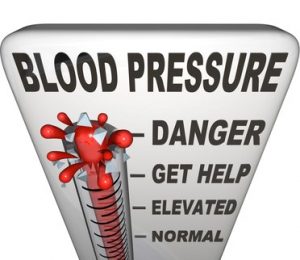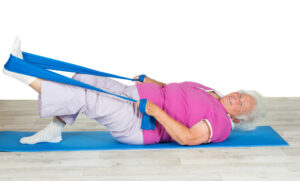How Can You Keep Your Blood Pressure Under Control?
Author: Dr. Stephen Chaney
 Hypertension (high blood pressure) is called a silent killer. That’s because you often don’t notice any symptoms until you die from a stroke or heart attack.
Hypertension (high blood pressure) is called a silent killer. That’s because you often don’t notice any symptoms until you die from a stroke or heart attack.
Nearly half of all American adults (120 million or 48%) have high blood pressure. Of Americans with high blood pressure:
- About half (46%) of them don’t know it.
And of those who know they have high blood pressure:
- Only half of them have it under control.
-
- In case you weren’t doing the math, that means that only 1 in 4 Americans with high blood pressure has it under control.
That is scary because every 20 mm Hg increase in systolic blood pressure:
- Doubles your risk of death from a stroke or heart attack.
And if the personal costs of high blood pressure were not enough, the cost of high blood pressure to our health care system is enormous.
- The CDC estimates that the cost of high blood pressure in the United States is around $131 to $198 billion per year. And this may be an underestimate because it does not include productivity losses from non-fatal illnesses caused by high blood pressure.
Medications are effective at reducing blood pressure, but they have significant side effects. And those side effects have two unintended consequences.
- Around half of patients stop taking their blood pressure medication within the first year because of side effects or cost.
- For patients who continue taking blood pressure medication, they are usually prescribed other medications to reduce the side effects from their blood pressure medication.
This is often the start of a downward spiral in which they need more medications to reduce the side effects of the medicines they were just prescribed. And they end up on multiple medications, and a poor quality of life because of it.
Because of this, many patients and health care practitioners are looking for natural ways to keep blood pressure under control. One of the most recommended approaches is to increase exercise, and the type of exercise most frequently recommended is aerobic exercise.
But is that the best advice? That advice is based on clinical studies performed 20 to 30 years ago. And those studies were an excellent example of “the tail wagging the dog”.
Let me explain. In the early days most experts believed that aerobic exercise would be the most effective exercise for reducing blood pressure. So, most of the original studies on the effect of exercise at reducing blood pressure were done using aerobic exercise.
From those studies we knew that aerobic exercise was effective at reducing blood pressure, but we didn’t really know whether it was the most effective exercise for reducing blood pressure. And more recent studies have suggested a more nuanced view of exercise and blood pressure control.
For that reason, the authors of the current article (JJ Edwards et al, British Journal of Sports Medicine, 57: 1317-1326, 2023) decided to conduct a comprehensive review of all randomized controlled studies between 1990 and February 2023 on the effect of exercise on reducing blood pressure.
How Was The Study Done?
 The investigators performed a comprehensive, systematic review of all randomized controlled studies (meaning patients were randomly assigned to an exercise or non-exercise group) looking at reductions in blood pressure following an exercise intervention of ≥ 2 weeks.
The investigators performed a comprehensive, systematic review of all randomized controlled studies (meaning patients were randomly assigned to an exercise or non-exercise group) looking at reductions in blood pressure following an exercise intervention of ≥ 2 weeks.
They excluded studies that:
- Included dietary counseling or exercise recommendations in the control group.
- Included dietary counseling, supplementation, or medication in the exercise group.
However, there were no exclusions based on the health or disease state in the patient population.
Their analysis included 270 randomized controlled trials with a total of 15,827 participants. All the studies reported systolic and/or diastolic blood pressure before and after the exercise intervention.
Exercise interventions were divided into five classifications:
- Aerobic exercises.
- Resistance exercises.
- Combined exercises (a combination of aerobic and resistance exercises).
- High-intensity interval exercises (high-intensity, short-duration exercises).
- Isometric exercises.
Several of these exercise classifications were further subdivided into individual exercises (see below)
Which Exercise Is Best For Reducing Blood Pressure?
 When the reduction in systolic blood pressure was considered, the rank order of exercise effectiveness was:
When the reduction in systolic blood pressure was considered, the rank order of exercise effectiveness was:
- High-intensity interval exercise (4.08 mm Hg reduction).
- Aerobic exercise (4.48 mm Hg reduction).
- Resistance exercise (4.53 mm Hg reduction).
- Combined aerobic and resistance exercise (6.04 mm Hg reduction).
- Isometric exercise (8.24 mm Hg reduction).
When the reduction in diastolic blood pressure was considered, the amount of reduction was less but the rank order of exercise effectiveness was the same:
- High-intensity interval exercise (2.50 mm Hg reduction).
- Aerobic exercise (2.53 mm Hg reduction).
- Resistance exercise (3.04 mm Hg reduction).
- Combined aerobic and resistance exercise (3.54 mm Hg reduction).
- Isometric exercise (4.00 mm Hg reduction).
When the exercise classifications were subdivided into individual exercises.
- Running and cycling were significantly more effective than walking for aerobic exercise, with running being the most effective form of aerobic exercise.
- Cycling was the most effective form of high-intensity interval exercise.
- No effect of exercise type was seen for the effectiveness of resistance training.
- Isometric wall squats and leg extensions were much more effective than isometric handgrip exercises.
There was not enough data from diastolic blood pressure studies to subdivide into individual exercises.
There were two other results of interest.
- Aerobic exercise interventions were slightly more effective with lower exercise frequency, suggesting that 3 times a week may be more effective than 5 or more times a week.
- All exercise interventions were much more effective for people with significantly elevated blood pressure than for people with slightly elevated blood pressure or normal blood pressure.
Of course, the important question for people with normal blood pressure is the effectiveness of exercise in preventing future increases in blood pressure, and this study is not designed to answer that question.
The authors concluded, “Various exercise training modes improve resting blood pressure, particularly isometric exercise. The results of this analysis should inform future exercise guideline recommendations for the prevention and treatment of arterial hypertension.”
What Does This Study Mean For You?
 The takeaways from this study are clear.
The takeaways from this study are clear.
If you wish to reduce your blood pressure:
- Any kind of exercise is helpful, but current recommendations that prioritize aerobic exercise may be misleading.
- If you want to get the most “bang for your buck”:
-
- Isometric exercise is the most effective and high intensity interval exercise is the least effective.
-
- Aerobic and resistance exercise are equally effective.
-
- A combination of aerobic and resistance exercise is more effective than either alone.
- And if you want to know the most effective individual exercises:
-
- Wall squats and leg extensions are the most effective isometric exercises.
-
- Running and cycling are the most effective aerobic exercises.
-
- Any kind of resistance exercise is equally effective.
Here are my thoughts about this study:
- If you haven’t been keeping up with clinical studies on exercise and blood pressure (like me), the conclusions of this comprehensive review are probably a surprise. I would not have expected isometric exercises to be more effective than aerobic exercises for lowering blood pressure.
- The authors of this review postulated that isometric exercise decreases blood flow to the muscles involved. When those muscles relax, blood flow increases which sends metabolic signals that cause blood vessels to relax.
- This study is good news for people with health conditions that limit their ability to do aerobic exercises or traditional resistance exercises.
- We also need to remember that lowering blood pressure is not the only value of exercise.
-
- Aerobic exercise improves cardiovascular function.
-
- Resistance exercise increases muscle mass, which is particularly important for seniors who are trying to maintain muscle mass and function. Regular resistance exercise also helps minimize bone loss as we age.
Isometric exercise can be considered a form of resistance exercise, but it may need to be supplemented with resistance exercises that target other muscle groups.
- As I said above, this study shows that all forms of exercise reduce blood pressure. The most effective exercise for you is the one you enjoy and will do on a regular basis.
- Finally, while this study looked at the effectiveness of different exercises at reducing high blood pressure, these findings are probably also applicable to the types of exercise that can reduce risk of developing high blood pressure as we age.
How Can You Keep Your Blood Pressure Under Control?
 Exercise alone is not a “magic bullet” for controlling blood pressure. And therein lies a story.
Exercise alone is not a “magic bullet” for controlling blood pressure. And therein lies a story.
One reason so many people choose medications to control their blood pressure is that there is no “magic bullet” natural approach for controlling blood pressure. Exercise is just one part of a holistic approach for controlling blood pressure that also includes:
- The DASH (Dietary Approaches To Stop Hypertension) was designed to prevent high blood pressure. I refer to it as an Americanized version of the Mediterranean diet.
Both diets are rich in fruits, vegetables, and whole grains and limit high fat meats and dairy products. And both diets have been shown to reduce the risk of high blood pressure.
- Weight control. Overweight and obesity are both associated with increased risk of high blood pressure. One estimate is that every two pounds of weight gain increases blood pressure by 1 mm Hg.
- Supplementation. The most effective supplements appear to be:
-
- Omega-3 fatty acids.
-
- Supplements containing grape seed extract and/or nitrates from beetroots and leafy greens.
-
- Calcium and magnesium if dietary intakes are not optimal.
Diet, weight control, supplementation, and exercise are the top 4 lifestyle factors for keeping blood pressure under control, but a comprehensive holistic approach to controlling blood pressure includes:
- Low sodium/potassium ratio. I mention it here for completeness, but it is an integral part of the DASH diet.
- Stress management. Chronic stress can increase blood pressure.
- Adequate sleep.
We may be outliers, but my wife and I have followed this approach for years and in our 80s have the blood pressure of teenagers.
The Bottom Line
Most experts recommend aerobic exercise for reducing blood pressure, but these recommendations are based on outdated studies. A recent study examined the effectiveness of various exercises at reducing blood pressure based on all randomized controlled clinical trials between 1990 and 2023.
This study shows:
If you wish to reduce your blood pressure:
- Any kind of exercise is helpful, but current recommendations that prioritize aerobic exercise may be misleading.
- If you want to get the most “bang for your buck”:
-
- Isometric exercise is the most effective and high intensity interval exercise is the least effective.
-
- Aerobic and resistance exercise are equally effective.
-
- A combination of aerobic and resistance exercise is more effective than either alone.
For more information on this study, what it means for you, and recommendations for a holistic approach for controlling blood pressure naturally, read the article above.
These statements have not been evaluated by the Food and Drug Administration. This information is not intended to diagnose, treat, cure or prevent any disease.
______________________________________________________________________________
My posts and “Health Tips From the Professor” articles carefully avoid claims about any brand of supplement or manufacturer of supplements. However, I am often asked by representatives of supplement companies if they can share them with their customers.
My answer is, “Yes, as long as you share only the article without any additions or alterations. In particular, you should avoid adding any mention of your company or your company’s products. If you were to do that, you could be making what the FTC and FDA consider a “misleading health claim” that could result in legal action against you and the company you represent.
For more detail about FTC regulations for health claims, see this link.
https://www.ftc.gov/business-guidance/resources/health-products-compliance-guidance
_____________________________________________________________________
About The Author
 Dr. Chaney has a BS in Chemistry from Duke University and a PhD in Biochemistry from UCLA. He is Professor Emeritus from the University of North Carolina where he taught biochemistry and nutrition to medical and dental students for 40 years. Dr. Chaney won numerous teaching awards at UNC, including the Academy of Educators “Excellence in Teaching Lifetime Achievement Award”.
Dr. Chaney has a BS in Chemistry from Duke University and a PhD in Biochemistry from UCLA. He is Professor Emeritus from the University of North Carolina where he taught biochemistry and nutrition to medical and dental students for 40 years. Dr. Chaney won numerous teaching awards at UNC, including the Academy of Educators “Excellence in Teaching Lifetime Achievement Award”.
Dr Chaney also ran an active cancer research program at UNC and published over 100 scientific articles and reviews in peer-reviewed scientific journals. In addition, he authored two chapters on nutrition in one of the leading biochemistry text books for medical students.
Since retiring from the University of North Carolina, he has been writing a weekly health blog called “Health Tips From the Professor”. He has also written two best-selling books, “Slaying the Food Myths” and “Slaying the Supplement Myths”. And most recently he has created an online lifestyle change course, “Create Your Personal Health Zone”. For more information visit https://chaneyhealth.com.
For the past 45 years Dr. Chaney and his wife Suzanne have been helping people improve their health holistically through a combination of good diet, exercise, weight control and appropriate supplementation.
